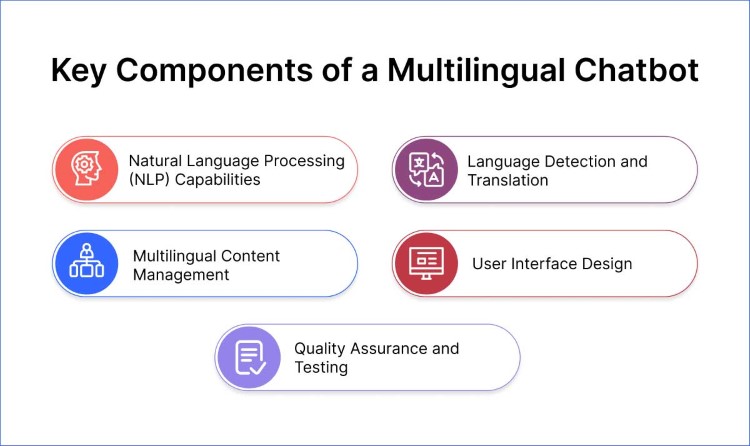Can you imagine that you’re effortlessly conversing with someone from across the globe and breaking through language barriers? That’s the magic of a multilingual chatbot that opens doors to seamless communication, bridging linguistic gaps and transforming interactions in our increasingly interconnected world.
The power of multilingual chatbots transcends boundaries, revolutionizing user experiences and redefining the way we connect.
In this article, let’s explore how we communicate in a global landscape by crafting these linguistic maestros and revealing their potential.
What is a Multilingual Chatbot?
A multilingual chatbot is an AI-powered conversational interface capable of understanding, processing, and responding to user queries in multiple languages. It’s designed to bridge language barriers, providing seamless communication and support across diverse linguistic audiences.
These chatbots leverage natural language processing (NLP) and translation capabilities to engage users in their preferred languages, catering to a global and multilingual user base.
What is the Need for Multilingual Chatbots?
As businesses expand their reach beyond borders, they encounter a rich tapestry of languages and cultures. Here’s why multilingual chatbots are indispensable:
- Globalization and Market Expansion: Companies aiming for international growth recognize the necessity of engaging diverse audiences. Multilingual chatbots serve as invaluable tools, breaking down language barriers and enabling businesses to connect with customers worldwide.
- Enhanced User Experience: Providing support in their native language drastically improves user experience, fostering trust and increasing customer satisfaction. Multilingual chatbots cater to this need by ensuring a personalized and comfortable interaction for each user.
- Customer Support and Accessibility: Undoubtedly, efficient customer support is a cornerstone of any successful business. Multi-language chatbot empowers companies to provide round-the-clock assistance in multiple languages. Also, it caters to a diverse customer base irrespective of time zones or geographical locations.
- Cost-Efficiency and Scalability: You can implement multilingual chatbots to streamline operations by reducing the need for large multilingual support teams. These bots offer scalable solutions, capable of handling numerous languages simultaneously, saving both time and resources.
- Competitive Edge: In today’s competitive landscape, offering multilingual support can be a distinguishing factor. Businesses that prioritize multilingual communication demonstrate a commitment to inclusivity, gaining an edge over competitors in global markets.
- Data and Insights: It generates valuable data across various languages and demographics. Analyzing these insights offers a comprehensive understanding of diverse markets, enabling businesses to refine their strategies and offerings.
Key Components of a Multilingual Chatbot
Building a multilingual chatbot requires a robust infrastructure and specialized components that enable seamless communication across different languages. These components include:
1. Natural Language Processing (NLP) Capabilities
- Language Understanding: NLP forms the backbone of multilingual chatbots, allowing them to comprehend and interpret various languages. Models like transformer-based architectures (e.g., BERT, GPT) enable understanding of context and nuances within different languages.
- Intent Recognition: NLP models identify user intents, irrespective of language, enabling the chatbot to comprehend user queries and provide relevant responses across diverse linguistic contexts.
- Named Entity Recognition (NER): NER plays a crucial role in identifying and extracting entities, such as names, locations, or products, in different languages, aiding in personalized and accurate responses.
2. Language Detection and Translation
- Language Identification: Accurate language detection algorithms determine the language used by the user in real time, allowing the chatbot to switch between languages seamlessly.
- Translation Services: Integration with translation APIs or services (e.g., Google Translate, Microsoft Translator) facilitates the conversion of user queries or responses from one language to another while maintaining context and accuracy.
3. Multilingual Content Management
- Content Localization: This involves creating and organizing language-specific content, including text, images, and multimedia, tailored to different linguistic audiences.
- Context Preservation: Ensuring that the translated content retains the intended meaning, tone, and context across languages, enhancing the user experience and preventing misinterpretations.
- Version Control and Updates: Efficient management of multiple language versions, including timely updates and modifications across all language variants to maintain consistency.
4. User Interface Design
- Language Selection Interface: Providing users with an intuitive interface to select their preferred language, ensuring ease of navigation and access to multilingual capabilities.
- Language-Specific Conversational Flows: Designing chatbot interactions that adapt to different languages, maintaining conversational flow and coherence while accommodating linguistic variations.
5. Quality Assurance and Testing
- Translation Accuracy Testing: Rigorous testing to ensure accurate translations, considering linguistic nuances, idiomatic expressions, and cultural sensitivity across different languages.
- User Experience Testing: Conducting user testing to verify the effectiveness of multilingual interactions, ensuring a seamless and intuitive experience across languages.
Building a Multilingual Chatbot: Step-by-step Guide
Let’s take a look at a comprehensive breakdown of the intricate process and a clear roadmap to craft and use a chatbot that is multilingual.
1. Language Selection and Analysis
- Identify Target Languages: Analyze your user demographics, market research, and target regions to determine the languages your chatbot should support. Consider factors like user preferences, business expansion plans, and market potential.
- Linguistic Analysis: Understand the linguistic complexities, cultural nuances, and dialectical variations within each language. This involves researching idiomatic expressions, variations in grammar, and local colloquialisms specific to each target language.
2. Choosing the Right Framework or Platform
- Evaluate Multilingual Capabilities: Assess various chatbot development platforms or frameworks (e.g., Dialogflow, Rasa, Microsoft Bot Framework) for their multilingual support features, scalability, and compatibility with your target languages.
- Selecting the Suitable Tools: Consider tools or APIs for language detection and translation services. Ensure they align with your project’s requirements in terms of accuracy, ease of integration, and cost-effectiveness.
3. Implementing Language Detection
- Integration of Language Detection: Incorporate language detection mechanisms into the chatbot’s architecture. Leverage NLP libraries or APIs capable of identifying the language used in user queries or messages.
- Testing and Validation: Verify the accuracy and efficiency of language detection algorithms through rigorous testing. Ensure they can accurately identify the language in real-time interactions.
4. Incorporating Translation Services
- Integrate Translation APIs: Implement translation services (e.g., Google Translate, Azure Translator) to facilitate seamless communication between languages. Ensure that translations maintain context, tone, and accuracy.
- Quality Assurance for Translation: Test translated content across various languages to ensure the accuracy of translations. Validate that the translations convey the intended meaning while maintaining cultural sensitivity.
5. Designing Language-Specific Conversational Flows
- Develop Language-Specific Flows: Create conversational paths for each supported language. This involves crafting language-specific responses, considering linguistic nuances, and adapting the conversational flow to suit each language’s structure.
- Consistency in User Experience: Ensure a consistent user experience across languages. Maintain uniformity in design elements, tone, and brand voice while accounting for linguistic variations.
6. Testing and Iteration
- Multilingual Testing: Conduct comprehensive testing across all supported languages. Check for translation accuracy, language-specific user experience, and the overall functionality of the chatbot in multilingual scenarios.
- Iterative Improvements: Gather feedback and data from multilingual interactions. Continuously iterate on the chatbot’s performance, refining language-specific responses and addressing any identified issues or linguistic challenges.
Challenges and Best Practices of Multilingual Chatbot
Navigating linguistic nuances and ensuring cultural sensitivity pose challenges in creating a seamless multilingual experience. Now let’s discover the best practices for effective implementation.
1. Handling Linguistic Variations and Idioms
Different languages have unique idioms and cultural references that might not directly translate. Capturing these nuances accurately can be challenging.
Best Practices:
- Contextual Understanding: Invest in NLP models that focus on contextual understanding to interpret idiomatic expressions within different languages.
- Localization Teams: Collaborate with linguists or localization experts to ensure accurate translations that preserve cultural context.
2. Ensuring Accuracy and Quality
Maintaining translation accuracy while preserving the original intent across languages poses a significant challenge.
Best Practices:
- Human Review: Incorporate a review process involving bilingual experts to validate translations for accuracy, tone, and cultural sensitivity.
- Continuous Improvement: Implement feedback loops and regular updates to refine translations based on user interactions and linguistic data.
3. Scalability and Maintenance
As the number of supported languages increases, maintaining consistency and scalability becomes complex.
Best Practices:
- Automated Workflows: Implement automated content management systems to streamline the addition and maintenance of new language versions.
- Modular Design: Create a modular architecture that allows for easy scalability and updates across all language variants.
4. User Experience Testing
Providing a seamless and uniform user experience across languages can be challenging due to linguistic differences.
Best Practices:
- Multilingual User Testing: Conduct extensive user testing with native speakers of each supported language to ensure usability and cultural appropriateness.
- Adaptive Design: Design the chatbot interface to dynamically adapt to linguistic variations without compromising user experience.
5. Data Privacy and Compliance
Different regions might have specific data privacy laws that need to be adhered to for each language.
Best Practices:
- Compliance Standards: Ensure the chatbot complies with language-specific data privacy regulations, employing encryption and secure data handling practices.
- Localization of Policies: Translate and adapt privacy policies and terms of use into all supported languages, clarifying data handling procedures for users in their native language.
6. Continuous Monitoring and Improvement
Chatbots need continuous monitoring and optimization to stay relevant and effective across multiple languages.
Best Practices:
- Analytics and Insights: Utilize analytics tools to gather data on user interactions in different languages, allowing for informed decisions regarding improvements and updates.
- Agile Approach: Embrace an iterative approach to implement changes and enhancements based on user feedback and evolving linguistic trends.
Key Benefits of Using a Multilingual Chatbot
There are many advantages of chatbots. Enhanced customer engagement, increased sales potential, and a competitive edge await businesses leveraging multilingual chatbots for global outreach and personalized interactions.
1. Boost Customer Engagement
- Real-Time Support: Multilingual chatbots provide instant assistance in users’ preferred languages, fostering immediate engagement.
- Accessibility: Breaking language barriers ensures a wider reach, encouraging more users to interact with the chatbot.
- Personalized Interactions: Tailored responses in users’ languages create a more personalized experience, leading to higher engagement rates.
- 24/7 Availability: Round-the-clock support across languages enhances engagement by being available whenever users need assistance.
- Interactive and Conversational: Offering a conversational interface in multiple languages makes interactions more engaging and intuitive for users.
2. Increase Sales Potential
- Expanded Market Reach: Catering to multilingual audiences opens doors to untapped markets, potentially increasing sales opportunities.
- Improved Customer Experience: Seamless communication in users’ native languages can positively influence purchasing decisions.
- Localized Sales Support: Guiding users through the sales process in their preferred languages improves understanding and trust, potentially boosting conversion rates.
- Cross-Border Transactions: Facilitating multilingual communication streamlines international sales, making transactions smoother and more accessible.
- Product Recommendations: Recommending products or services in users’ languages based on preferences enhances the sales potential by providing a more personalized shopping experience.
3. Enhance Customer Loyalty
- Effective Communication: Clear, accurate, and friendly communication in users’ languages fosters a sense of trust and loyalty.
- Customer Satisfaction: Resolving queries promptly and efficiently leads to higher satisfaction levels.
- Building Rapport: Speaking in customers’ languages helps in building stronger relationships, and fostering loyalty and long-term engagement.
- Addressing Concerns Effectively: Resolving issues in users’ languages shows commitment to their satisfaction, nurturing loyalty, and advocacy.
- Consistent Support: Offering consistent and reliable support in multiple languages creates a positive perception, increasing customer loyalty.
4. Secure Your Competitive Edge
- Market Differentiation: Providing multilingual support distinguishes your brand, setting it apart from competitors.
- Global Market Penetration: A multilingual approach allows for better penetration into diverse global markets.
- Brand Perception: Brands that prioritize multilingual communication are perceived as more inclusive and accommodating, giving them a competitive advantage.
- Adaptation to Global Trends: Staying ahead by adapting to the trend of catering to diverse audiences positions your brand as forward-thinking and globally relevant.
- Improved Brand Image: Demonstrating a commitment to serving diverse audiences through multilingual chatbots enhances brand reputation and competitiveness.
Future Trends and Innovations of Multi-language Chatbot
1. Advanced Natural Language Processing (NLP)
- Contextual Understanding: NLP models are evolving to comprehend context better, allowing chatbots to interpret user intents with higher accuracy across multiple languages.
- Multilingual Transfer Learning: Advancements in transfer learning techniques enable chatbots to leverage knowledge from one language to improve performance in another. It reduces the need for extensive language-specific training data.
2. AI-Powered Language Generation
- Multilingual Generative Models: AI-driven language generation models, like GPT (Generative Pre-trained Transformer) variants, continue to improve, enabling chatbots to generate more contextually relevant and coherent responses in multiple languages.
- Customizable Language Styles: Innovations might allow users to select language styles or tones, tailoring the chatbot’s responses to match cultural nuances or individual preferences.
3. Enhanced Language Detection and Translation
- Real-Time Translation: Advancements in translation APIs might lead to near-real-time, high-accuracy translations within chatbot interactions, ensuring smoother multilingual conversations.
- Improved Multimodal Translation: Integrating text with other modalities like images or voice for seamless multilingual communication, breaking barriers beyond textual exchanges.
4. Emphasis on Cultural Sensitivity and Localization
- Cultural Adaption: Future chatbots may focus on adapting not only language but also cultural references and sensitivities, ensuring more culturally relevant and respectful interactions across diverse audiences.
- Localized User Experience: Innovations will likely revolve around providing more tailored experiences based on specific cultural norms and regional preferences.
5. Omni-lingual Chatbots and Multi-Modal Interfaces
- Omni-lingual Capabilities: Chatbots are capable of seamlessly switching between multiple languages within a single conversation, catering to users who are proficient in multiple languages.
- Integration with Various Interfaces: Integration with voice, augmented reality (AR), or virtual reality (VR) interfaces to facilitate multilingual interactions in diverse settings beyond text-based exchanges.
6. Ethical and Regulatory Considerations
- Ethical Language Use: Chatbots might be developed to ensure ethical and responsible language use across various cultures, avoiding offensive or insensitive language.
- Compliance with Data Privacy Laws: Adherence to stringent data privacy laws specific to different regions and languages, ensuring user data protection in multilingual interactions.
Summary
The multilingual chatbot isn’t just about breaking language barriers; it’s about forging connections, fostering understanding, and shaping a global community that thrives on seamless communication.
As we witness the evolution of multilingual chatbots, let’s not just envision technology that speaks various languages; let’s imagine a world where every interaction is a bridge, every conversation a celebration of diversity.
The future of multilingual chatbots isn’t just about words; it’s about building a world where understanding knows no bounds. Together, let’s chat our way into a future where language is no longer a barrier, but a gateway to unity and shared experiences.







